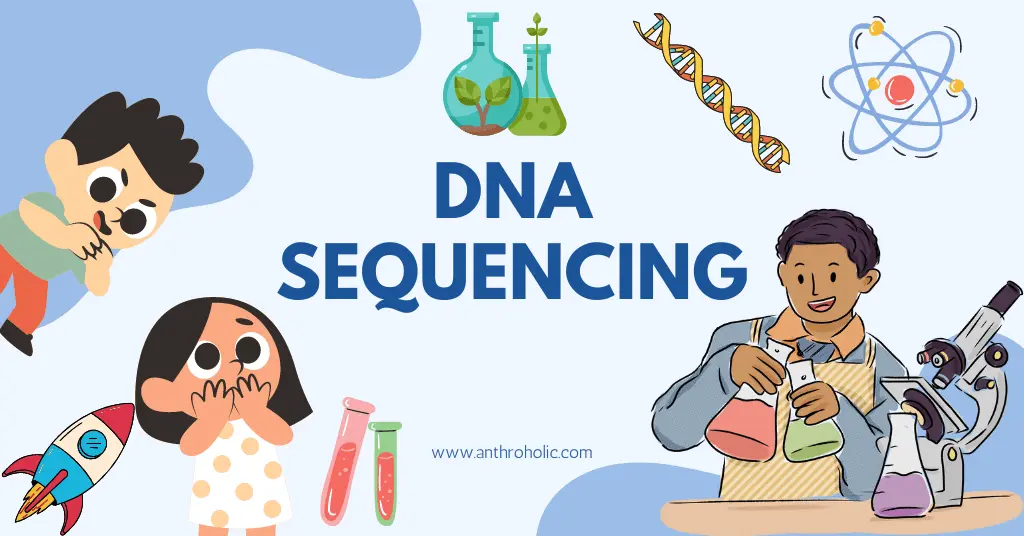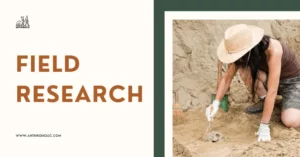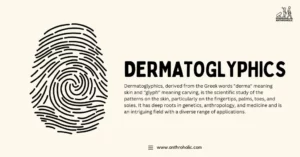AI Answer Evaluation Platform Live Now. Try Free Answer Evaluation Now
DNA Sequencing
Anthropology and genetics are two fields that at first glance may appear disparate. The former examines social behaviors, cultures, and development from a humanistic perspective, while the latter delves into the world of genes, heredity, and life at its most microscopic levels. Despite their apparent differences, anthropology and genetics are entwined in a dynamic interplay that has drastically revolutionized our understanding of human history, evolution, and diversity.

Genetics offers a lens to view human history from a biological perspective, tracing our roots back to the very first humans. This view complements anthropological investigations, offering a narrative of humanity that is rooted in the hard evidence of our DNA. Through this interplay, scientists can investigate human migration patterns, detect interbreeding between different hominid species, and study the evolution of disease resistance.
- The Significance of DNA Sequencing in Anthropology
- The Dawn of DNA Sequencing: From First Steps to Modern Techniques
- Technological Advancements and Their Anthropological Impact
- Understanding Human Migration and Ancestry
- Unraveling Ancient Civilizations and Cultures
- The Role of DNA Sequencing in Anthropology of Disease
- Future Prospects of DNA Sequencing in Anthropology
- Conclusion
- References
The Significance of DNA Sequencing in Anthropology
- Since its inception, DNA sequencing has transformed numerous fields, and anthropology is no exception.
- The sequencing of DNA – the very code of life – has significantly broadened our understanding of the deep past, allowing scientists to trace back human lineages to their roots and uncovering the intricacies of human evolution.
- DNA sequencing in anthropology enables the investigation of population genetics, understanding how populations have changed, moved, intermingled, or remained isolated over time.
- This technology is key to studies of human migration and ancestry, helping to map the course of human history across the globe [1].
- Additionally, DNA sequencing can provide insights into the evolution of diseases, helping anthropologists to trace the history of disease outbreaks and human adaptation to them.
- In sum, DNA sequencing has profoundly impacted anthropology, offering new methodologies and insights to address age-old questions about who we are, where we came from, and how we became the diverse species we are today.
The Dawn of DNA Sequencing: From First Steps to Modern Techniques
The journey of DNA sequencing began in earnest in the mid-20th century. With the unveiling of the DNA structure by James Watson and Francis Crick in 1953, scientists recognized that within these double helices lay the code of life [2]. It took two more decades for the first DNA sequencing techniques to be developed, with the notable advent of Sanger sequencing by Frederick Sanger in 1977 [3]. This method, although laborious and time-consuming, paved the way for the genomic era, facilitating the first human genome project which was completed in 2003 [4].
The advent of next-generation sequencing (NGS) technologies in the early 21st century revolutionized DNA sequencing. NGS platforms could generate large amounts of sequence data rapidly and affordably, accelerating the pace of genetic research. With these advancements, sequencing a whole human genome became increasingly accessible, opening up a plethora of opportunities for anthropological research.
Technological Advancements and Their Anthropological Impact
- The impact of these technological advancements on anthropology has been profound. NGS technologies, coupled with the ability to extract DNA from ancient remains, have reshaped the study of human evolution and migration.
- For example, sequencing the Neanderthal genome provided definitive evidence of interbreeding between Neanderthals and early modern humans, revising our understanding of human evolutionary history.
- DNA sequencing has also revolutionized anthropological studies of disease. By sequencing the genomes of ancient pathogens, we can trace the historical trajectory of diseases and understand how they shaped human history.
- For instance, sequencing the DNA of the Yersinia pestis bacterium from medieval skeletons confirmed it as the cause of the Black Death and revealed how the pathogen evolved over time.
- Furthermore, sequencing technologies have democratized genomics, leading to the rise of personal genomics companies.
- These companies sequence individuals’ genomes to provide insights into their ancestry and genetic predispositions, creating a new way for individuals to explore their heritage and identity.
- However, these technological advancements also present new challenges.
- Ethical considerations regarding the ownership, interpretation, and use of genetic data have become increasingly important.
- Ensuring privacy, informed consent, and equitable access to the benefits of genomic research are critical concerns in the age of genomic anthropology.
Understanding Human Migration and Ancestry
DNA sequencing has played a transformative role in understanding human migration and ancestry. For instance, the application of whole-genome sequencing techniques to modern human populations has helped researchers trace migration routes our ancestors took out of Africa [5]. DNA sequences have been used to reconstruct a phylogenetic tree of human populations, reflecting the relationships between different ethnic groups and the timeline of their divergence.
Moreover, the sequencing of ancient DNA has provided a more nuanced understanding of human history. It has confirmed instances of interbreeding between early modern humans and archaic hominins, like Neanderthals and Denisovans, that have contributed to the genetic diversity we see today. This ability to trace our roots, understanding not only where we came from but also how we are related, is invaluable to anthropology.
Neanderthals and Modern Humans: Interbreeding and Its Consequences
The application of DNA sequencing to the study of human evolution took a revolutionary turn when the Neanderthal genome was sequenced in 2010 [6]. This achievement provided definitive evidence that Neanderthals and early modern humans interbred, challenging the previously held notion of an entirely separate lineage. It was found that up to 2% of the DNA of non-African modern humans can be traced back to Neanderthals, demonstrating the profound evolutionary impact of this interbreeding. These Neanderthal-derived sequences in our genome have further been linked to certain health-related traits in modern humans, such as the risk of developing specific diseases, and traits related to skin pigmentation and hair texture.
DNA Sequencing and the Mystery of the Denisovans
The Denisovans, another group of ancient hominins, were discovered through DNA sequencing before any physical description was available. This enigmatic group was first known from a tiny finger bone fragment found in the Denisova Cave in Siberia, from which an entire genome was sequenced. Like Neanderthals, Denisovans also interbred with modern humans, with significant contributions to the genomes of present-day Melanesian and Australian aboriginal populations [7]. This highlights the power of DNA sequencing in unearthing hidden chapters of human evolutionary history.
Unraveling Ancient Civilizations and Cultures
In addition to providing a genetic roadmap of human migration and ancestry, DNA sequencing has shed light on ancient civilizations and cultures. The study of ancient DNA allows researchers to investigate the lifestyles, societal structures, and health status of past societies. It offers an invaluable window into human history, revealing insights that complement archaeological findings.
For example, DNA sequencing has provided insights into the social organization of prehistoric cultures. In a striking case, researchers discovered a high degree of matrilineal genetic continuity in a prehistoric German farming community, suggesting a societal structure where males moved to their wives’ settlements upon marriage [8].
The Role of DNA Sequencing in Anthropology of Disease
The study of disease has been another significant application of DNA sequencing in anthropology. By sequencing the genomes of ancient pathogens, researchers have been able to trace the historical trajectory of diseases and understand how they’ve shaped human evolution. DNA sequencing has allowed researchers to investigate past pandemics, such as the Black Death and the 1918 influenza pandemic, providing insight into the evolution of these diseases and their impacts on human society.
Uncovering Ancient Plagues: The Case of Yersinia pestis
In a ground-breaking study, researchers used DNA sequencing to confirm that Yersinia pestis was the causative agent of the Black Death, a plague that wiped out about 50% of Europe’s population in the 14th century [9]. The analysis also showed that this strain of the bacterium was ancestral to all modern strains, significantly contributing to our understanding of the history and evolution of this deadly pathogen. This study underscores the potential of DNA sequencing to reveal the history of diseases and their impacts on human civilization.
Future Prospects of DNA Sequencing in Anthropology
As we look forward, the potential applications of DNA sequencing in anthropology are vast and exciting. The technologies associated with genetic analysis continue to become more sophisticated, and as a result, more intricate aspects of human history are coming to light.
One of the most promising developments is the increasing feasibility of sequencing even more ancient DNA. With the refinement of techniques to recover and sequence DNA from old and degraded samples, our ability to explore further into the past will expand. Further advancements in metagenomics – the study of genetic material directly recovered from environmental samples – will provide deeper insights into the interactions between humans and their environments over time. Furthermore, the incorporation of bioinformatics, statistical methods, and computational algorithms into the anthropological domain will help manage and interpret the massive datasets generated by whole-genome sequencing.
Conclusion
The field of anthropological genomics is continuously evolving, and several exciting future directions and emerging trends are shaping the landscape of DNA sequencing in anthropology. These developments hold tremendous potential for advancing our understanding of human history, diversity, and the intricate interplay between genes, culture, and environment.
The future of DNA sequencing in anthropology is full of promise. Advancements in technology, data analysis, and interdisciplinary collaborations will enhance our understanding of human history, migration, adaptation, and cultural diversity. By harnessing the power of DNA sequencing alongside other data sources, anthropology will continue to unravel the complex tapestry of human existence, ultimately contributing to our collective knowledge of the human story.
References
[1] Reich, D. (2018). Who We Are and How We Got Here: Ancient DNA and the New Science of the Human Past. Pantheon Books.
[2] Watson, J. D., & Crick, F. H. (1953). Molecular structure of nucleic acids: a structure for deoxyribose nucleic acid. Nature, 171(4356), 737-738.
[3] Sanger, F., Nicklen, S., & Coulson, A. R. (1977). DNA sequencing with chain-terminating inhibitors. Proceedings of the National Academy of Sciences, 74(12), 5463-5467.
[4] Lander, E. S., Linton, L. M., Birren, B., Nusbaum, C., Zody, M. C., Baldwin, J., … & Funke, R. (2001). Initial sequencing and analysis of the human genome. Nature, 409(6822), 860-921.
[5] Reich, D., Thangaraj, K., Patterson, N., Price, A. L., & Singh, L. (2009). Reconstructing Indian population history. Nature, 461(7263), 489-494. https://www.ncbi.nlm.nih.gov/pmc/articles/PMC2842210/
[6] Green, R. E., Krause, J., Briggs, A. W., Maricic, T., Stenzel, U., Kircher, M., … & Pääbo, S. (2010). A draft sequence of the Neandertal genome. Science, 328(5979), 710-722.
[7] Reich, D., Green, R. E., Kircher, M., Krause, J., Patterson, N., Durand, E. Y., … & Pääbo, S. (2010). Genetic history of an archaic hominin group from Denisova Cave in Siberia. Nature, 468(7327), 1053-1060.
[8] Haak, W., Forster, P., Bramanti, B., Matsumura, S., Brandt, G., Tanzer, M., … & Burger, J. (2008). Ancient DNA from the first European farmers in 7500-year-old Neolithic sites. Science, 310(5750), 1016-1018.
[9] Bos, K.I., Schuenemann, V.J., Golding, G.B., Burbano, H.A., Waglechner, N., Coombes, B.K., … & Poinar, H.N. (2011). A draft genome of Yersinia pestis from victims of the Black Death. Nature, 478(7370), 506-510. https://pubmed.ncbi.nlm.nih.gov/21993626/




